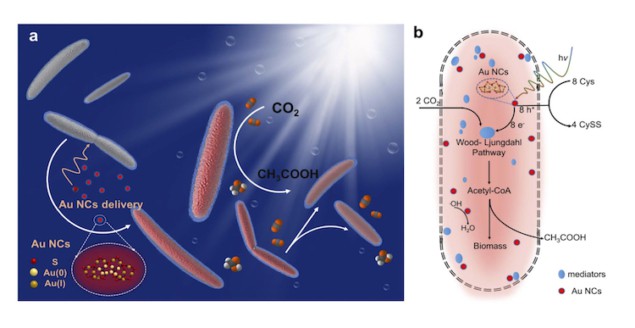Gold nanoclusters turn bacteria into photosynthetic machines
03 Oct 2018 Belle Dumé
Researchers have discovered a way to place light-absorbing nanoclusters of gold inside a non-photosensitive bacterium to produce a catalytic photosynthetic biohybrid that can generate fuel from sunlight. The new system generates a higher yield of chemical products than a previous model and works continuously for several days.
During photosynthesis, plants harness solar radiation and convert it into energy. Most artificial photosynthesis systems try to mimic this natural process. “Photosynthetic biohybrid systems, for example, aim to link preassembled biosynthetic pathways with inorganic light absorbers,” explains Peidong Yang of the University of California at Berkeley, who led this research effort. “This strategy makes use of both the light-harvesting efficiency of solid-state semiconductors with the superior catalytic performance of whole-cell microorganisms.”
Non-photosensitive bacterium carries out artificial photosynthesis
In their new work, Yang and colleagues have used ultrasmall gold nanoclusters as biocompatible photosensitizers and placed them inside a non-photosynthetic bacterium, M. thermoacetica. The researchers are familiar with this microorganism since they had already studied it as the first ever non-photosensitive bacterium to carry out artificial photosynthesis. “In this previous work, we attached light-absorbing nanoparticles made of cadmium sulphide (CdS) to the bacterial membrane and turned M. thermoacetica into a tiny photosynthetic machine that converts sunlight and carbon dioxide into useful chemicals,” says Yang.
“We have now found a way to place light-absorbing gold nanoclusters (AuNCs) inside the bacterium and have made a catalytic biohybrid that yields a higher quantity of chemical products than its predecessor.”
The researchers originally chose CdS because it absorbs visible light. This semiconductor is toxic to bacteria, however, so the nanoparticles had to be attached extracellularly to the bacterial cell membrane. When sunlight excites a CdS nanoparticle, an electron is generated and this electron then passes through the cell wall before being injected into the CO2 reduction cycle inside the bacterium.
“As these photogenerated electrons travel though the bacterium, they interact with multiple enzymes to trigger a cascade of reactions that eventually turn CO2 into acetic acid, which is a valuable chemical intermediate for making solar fuels,” says Yang. “However, in the extracellular setup, the electrons end up interacting with other chemicals that play no part in this important CO2 reduction process. As a result, some electrons are lost during this transfer process and never reach the enzymes.”
Intracellular photosensitization
“To improve the bacterium’s ability to produce acetic acid from CO2 each time it gains an electron (a performance metric also known as its ‘quantum efficiency’), we used another semiconducting material in the form of Au22nanoclusters,” he tells Physics World. “This material also efficiently absorbs light but we can place it inside the bacterium and so photosensitize its interior. The electrons from these intracellular Au nanoclusters can be directly passed onto the so-called Wood–Ljungdhal CO2 reduction pathway, so bypassing the problems encountered in our previous system.”READ MORE

And that is not all: the AuNCs also inhibit reactive oxygen species (ROS) such as H2O2and OH, which are generated from the photooxidative process associated with this photosynthesis. “As these ROS accumulate, they become harmful for the bacteria. Inhibiting these ROS thus allows the microorganisms to remain viable for a longer period (six days) and continuously produce biofuel over this time,” says Yang.
The researchers report their efficient new photosynthetic biohybrid system in Nature Nanotechnology 10.1038/s41565-018-0267-z.

Belle Dumé is a contributing editor to Physics World
8/10/2018 FROM PHYSICSWORLD.COM

Δεν υπάρχουν σχόλια:
Δημοσίευση σχολίου